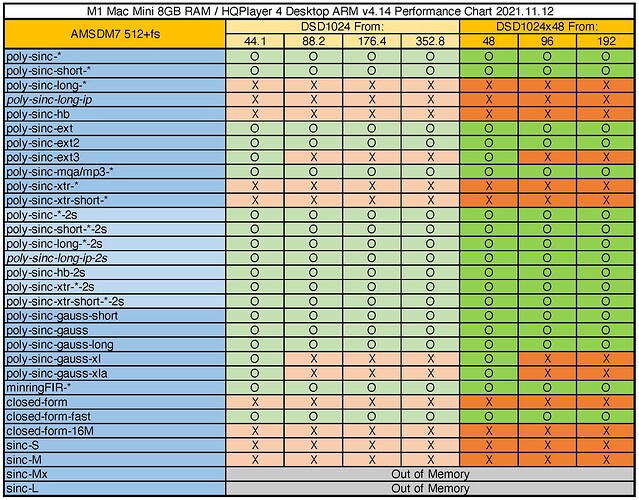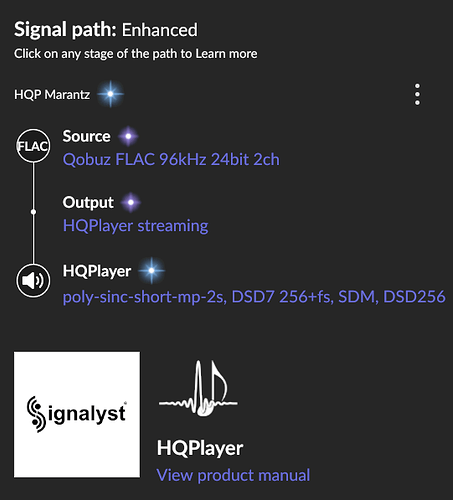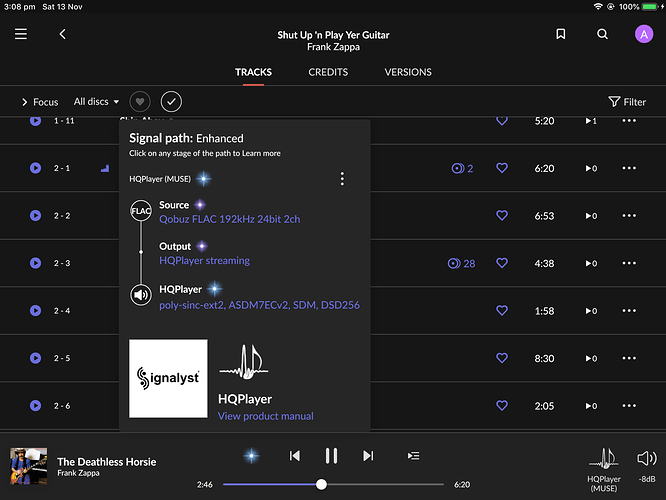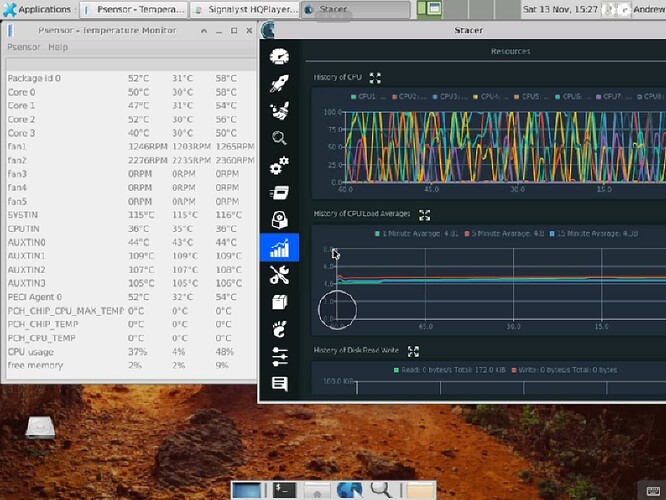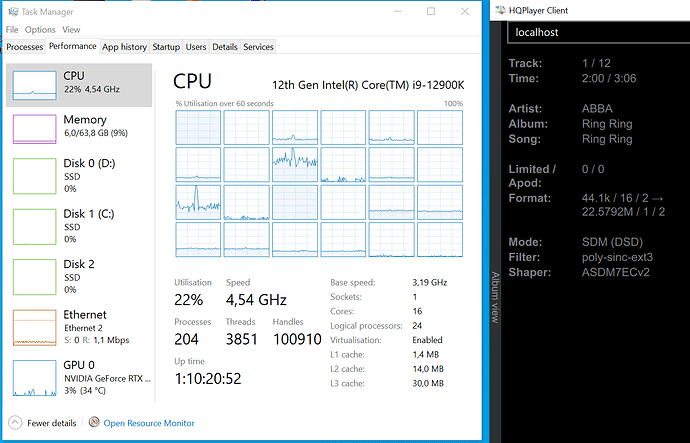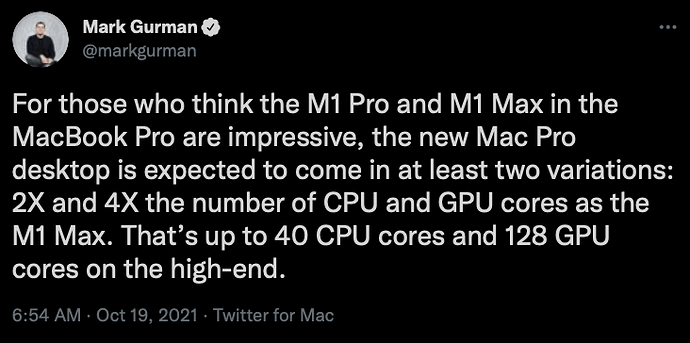Hi all,
I made another M1 Mac mini performance chart for oversampling to DSD1024 using AMSDM7 512+fs.
Performance requirement is similar to DSD256 using ASDM7EC. If your DAC supports DSD1024 / DSD1024x48, it’s worth a try.
Had never tried ext3 before. Not sure why.
Wowza it is nice. Enjoying it during late night listening headphones listening at my desk.
Apple Music Hi-Res on iOS → UpBoard Gateway USB Class Audio 2 input → HQP OS 4.27.1 UAC2 NAA input → DSD256 ext3 ASDM7ECv2 → RPi4 NAA USB → RME ADI-2 (DSD Direct conversion mode) XLR out → SMSL SP400 THX 888 Headphone amp → Focal Utopia headphones (HQPlayer also doing headphones EQ to Harman Target Curve)
That looks complex but I just plug my iPad/iPhone/Macbook into a little Intel Atoms fanless box (UpBoard Gateway) and incredible sound quality comes out the headphones 
I hit play on Apple Music/Spotify/Deezer/Tidal (of course I use Roon but much less these days) and it all goes through HQPlayer.
Big thanks to @jussi_laako not just for the upsampling but all the other amazing features of HQPlayer that don’t get discussed as much.
This has quickly become one of my all time favourite tracks. Highly recommended !
oh, boy! the track is so gooooood !!!
my path Qobuz/Roon → HQPe → MAY
doing it with poly-sinc-short-mp into ASDM5EC @ SDM 256
@jussi_laako +1000
I sit in the same room as my system so don’t want the fans kicking in, but for now using the following NUC:
![]()
I can run with:
Before the fans kick in. ~53%CPU Utilization.
Not too shabby.
Gave it a more extended workout, played 192kHz 24 bit streaming Qobuz for >1hr. No dropouts.
I suspect the previous single dropout was a streaming issue. CPU seems fine. I should probably add another stick of RAM, only got 8GB atm.
Very nice indeed
Is anyone using HQP Desktop for DSD64 multichannel with convolution filtering at PCM 384, playing back at DSD64 or DSD128? If so, what processor, GPU and HQP settings are you using? Thanks. JCR
On the new i9-12900K I got even DSD512 working with ASDM7ECv2, but it is right on the edge. Multicore DSP forced full-on. This is with DDR4-3600 CL17 RAM. I’d expect notably better results with DDR5, but it seems to be very hard to get at the moment, just like most GPUs. This case is with CUDA offload disabled.
And that’s without any special 12900K architecture HQP optimisations ?
That’s just ‘out of the box’?
So potential for improvement?
Yes, with current 4.14.0 release as it is.
Will need to do some work to detect the efficiency cores from performance cores on Windows and Linux.
This guy at Bloomberg hasn’t gotten any ‘leaks’ wrong in a long time.
I doubt there will be a step backwards in single core performance either.
This will be a statement product for Apple Silicon. As if M1 Max (mobile class!) isn’t already impressive.
I thought that M1 Pro/Max single-core performance was roughly the same as M1, and it’s only the additional performance cores above the 4 in the M1 that allow HQP to do heavier lifting on the filter side of processing (assuming the 1st 4 performance cores are used for modulation). But maybe there are additional improvements in cross-core communication, etc. Still haven’t seen real-world results with M1 Max and HQP - have you?
If the Mac Pro M1 variations are just about additional cores I am unclear if it will be of benefit to HQP.
M1Pro has double the memory bandwidth compared to M1. And M1Max has four times the memory bandwidth compared to M1. This already makes some amount of difference.
One user sent me some results with M1Max compared to M1 and it indeed seems to perform better. Some of the results were more around multichannel playback, where of course increased number of performance cores helps significantly.
For such product I would expect them to ditch the efficiency cores and replace those with additional performance cores or GPU cores. Similar to Intel’s plans for bigger 12th Gen CPUs (Xeons).
Yep but remember M1 Max is still mobile class CPU - Macbook Pro.
Mac Pro CPU is pure desktop so I don’t think you can look at that pattern between the mobile CPUs so far.
I’ve been trying the same settings on my M1 mini, and I 100% agree (been listening to DSD 256 with 7EC for the past week and something was missing)
Yepp, it sure is. Sorry for reply in such an anxient comment, but I just read it after a long time off-grid, diving deep into other mysteries of life. I still run -xla. I oughta’ experiment cuz’ new setup, but it sounds so great still so I have not seen the reason yet. ? Perhaps you now trigger me into Duracell-bunny-mode? (i.e. jumping all over the place. So tiring, but inevitable with the right trigger). I have been curious about EXT3 …
I liked ext3 at first, but I found it tiring after awhile, similar effect as gauss-xla. Long filters for some reason bother my hearing, back on ext2. I find I can listen for long periods with that. I don’t know why.
My favorite is the EC7v2 + Sinc-Gauss-Long at 48xDSD256, followed by EXT2. Planning a new build to get to same modulator+filter combo setting at 48xDSD512.
Is that more fatiguing with PCM44.1k content? Or higher rate?
Or with all rates?
I definitely found gauss-xla too fatiguing long term. Less with ext3 but will spend more time with it.
I use 1x = ext3 and Nx = ext2. Not really for CPU load reasons (11900K) but because most stuff above 30kHz (i.e. for PCM88.2kHz and higher music) is high frequency hash/noise, not really music.
I think ext2 will filter more of that crap out, for PCM88.2kHz and above music.
Sample rates above 44.1k might be great for capturing a bit more music but lots of times have more crap too.
Not all the time. There are some really pristine hi-res stuff out there (looking at spectrogram). But even with those - there’s rarely anything past 30kHz in there.
